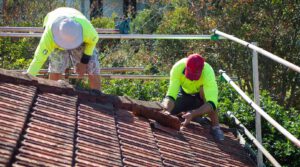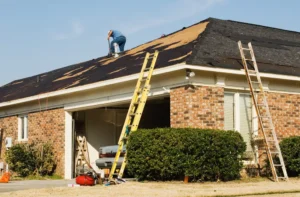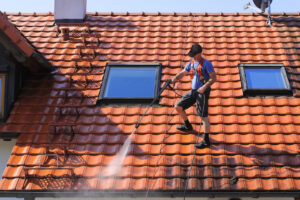Roofing Company Orlando protects the interior of a structure from rain, snow, sunlight, and other elements. Roofing involves the construction and installation of roofs.
Rafters or pre-fabricated trusses support the roof decking or sheathing. The sheathing may be plywood or OSB. Underlayment and vapor barriers are applied to prevent leaks. They were flashing seals point where the roof changes direction.

Asphalt shingles are a traditional choice for residential roofing. They are a durable, affordable option for various home styles and aesthetics. They are versatile enough to work around unique roof features like chimneys and skylights. They are easy to install, even for DIYers with little prior roofing experience.
When it comes to the color of your shingle roof, you have many choices, from earthy browns and grays to eye-catching blues and purples. These colors can complement trim, paint colors, and landscaping for a cohesive look that elevates your home’s curb appeal.
The shingles are made of three layers:
- An organic or inorganic base mat
- A layer of waterproof asphalt
- Ceramic-coated opaque mineral granules
The granules color the shingles and help protect the asphalt from damage from the sun’s UV rays. The back of each shingle is treated with sand, talc, or mica to prevent the shingles from sticking together during manufacturing and transportation.
3-tab shingles are the most common type of asphalt shingle used in roofing projects. They are lightweight and inexpensive but lack the longevity and durability of other kinds of shingles. Dimensional and luxury shingles have more appeal, with architectural shingles having the highest level of curb appeal. These shingles are thicker than their 3-tab counterparts, creating more definition and a dramatic appearance.
Asphalt shingles can also be manufactured to mimic the look of other roofing materials, including slate and cedar shakes. These shingles can elevate your home’s curb appeal and add to its value.
In addition to the benefits mentioned above, asphalt shingle roofs are energy efficient. The reflective coatings in these shingles can reflect the sunlight and lower your home’s energy costs during hot summers. These shingles are also recyclable and environmentally friendly, making them an excellent choice for homeowners who want to go green with their roofing. A well-maintained asphalt shingle roof can last up to 30 years.
Clay tiles are the perfect option when searching for a roofing material that will add an exotic flair to your home and increase its value. Whether made from fired clay or concrete, this roofing option is durable and has been used for centuries in many countries worldwide. While it may cost more than shingles, this investment will last you for years.
Unlike other roofing materials, clay roof tiles are naturally fire-resistant. This makes them a good choice for homes in areas that are prone to wildfires. They also offer superior insulation capabilities that can help reduce your energy consumption.
These tiles are available in various shapes, sizes, and colors. They can also be customized to fit any architectural style. Clay tile roofs are often recommended for Southwest and Mediterranean-inspired homes. However, they are only ideal for some homes because they can be fragile and require more maintenance than other roofing options.
Like asphalt shingles, clay tile roofs are available in glazed and unglazed varieties. Glazed clay tiles are coated with a special resin, which helps protect them from stains and scratches. This coating also provides added protection from moisture and UV rays. Unglazed clay tiles are less durable but less expensive and more eco-friendly than glazed tiles.
A clay tile roof’s durability and insulation benefits make it a great choice for homeowners who want to stay green and save money on energy bills. This roofing material has a low environmental impact during manufacturing and can be recycled at the end of its lifespan. In addition, it is a sustainable roofing option that requires minimal maintenance to keep it in top condition.
The main drawback of a clay tile roof is its weight. It can weigh up to 1780 lbs per square foot, which can put additional stress on the structure of your house. You must consult a professional to determine if your home’s framing and structure can support this type of roofing. Additionally, a clay tile roof is less durable in freeze-thaw climates and can crack and break if walked on by heavy traffic.
Metal roofs have long been popular on industrial buildings and barns, but they are also gaining popularity as an option for residential homes. They can be made from various alloys, including steel, aluminum, and copper. These alloys can be rolled into sheets and cut into widths, lengths, and profiles. Their strength, durability, and a wide array of colors and finishes allow them to fit into any architectural style.
The most common type of metal roofing is galvanized steel, also known as corrugated metal. The zinc coating protects the steel from corrosion and makes it stronger. Galvanized steel has a lifespan of 50 years or more, making it one of the longest-lasting roofing materials available. A newer variation is Galvalume, which combines steel with both zinc and aluminum for added protection. It has a lifespan of 60 to 70 years, which is close to that of asphalt shingles.
Other types of metal roofs include galvanized aluminum and weathering steel. These are both lightweight metals that can be used in coastal areas. They corrode differently than steel, however. Galvanized aluminum has a softer surface that may require more maintenance but can withstand salt air and abrasive debris. Weathering steel has a harder, more durable surface that can withstand severe weather and even some brush fires.
While metal is a strong material, it is prone to damage from hail and falling objects. It is best to have a heavy-duty roof if you live in a stormy region. Even pea-sized hail can cause dent marks, though larger hail has been known to destroy asphalt shingle roofs.
A metal roof can be installed similarly to an asphalt shingle roof, but installation costs can be higher. It is important to choose a metal roofing contractor who is familiar with the different panels and styles. The contractor should be willing to answer any questions and provide samples of different colors and styles. Also, find out how the contractor will handle the expansion and contraction of the roof. This is because metal can expand and contract more than other roofing materials, resulting in a mismatched appearance or exposed fasteners that will degrade over time.
Slate is a durable, long-lasting roofing material in various attractive colors and shades. It is also resistant to heat, which can help homeowners save on energy costs. It can also protect against water leaks, and it is an eco-friendly option that does not emit toxic gases when exposed to extreme heat or fire.
Slate roofs are available in a wide range of shapes and sizes, making them ideal for any style home. They can be installed on sloped roofs or flat roofs, as well as on gable and mansard roofs. They are typically constructed from natural stone, although slate tiles can be manufactured in various other materials, such as fiberglass.
The price of a slate roof can vary, depending on the thickness and color. Harder, more durable slate is more expensive than softer varieties but more resilient and requires less maintenance. More delicate varieties are cheaper but may only last for a short time, and they are prone to fading over time.
When installing a slate roof, it is essential to consult with a professional. While this is true for all roof installations, it is especially important when working with a slate roof, as the material can be fragile and susceptible to damage if handled improperly.
Additionally, slate is a heavy roofing material that can add significant weight to the structure of a house. As a result, it is important to ensure that the roof deck and rafters are in good condition before adding slate tiles. If not, the rafters could sustain damage and structural issues due to the added weight of the tiles.
Lastly, it is also important to remember that slate roofs require regular maintenance and may need repair or replacement over the years. If this concerns you, consider choosing a synthetic slate roof. This newer roofing solution eliminates many common problems associated with traditional slate while retaining its elegant appearance.
A slate roof can boost a home’s resale value by increasing its aesthetic appeal. Prospective homeowners often check the roof when searching for a new home, and potential buyers are likely to be turned off by an old, worn-out roof. On the other hand, a house with a slate roof is more likely to sell quickly and for a higher price.


